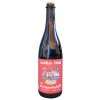Dogfish Head Craft Brewery - Zwaanendale
-
ABV:
8.0%
The last three days of September this year marked the 25th anniversary of the Great American Beer Festival in Denver, Colorado. I was pleased once again to judge some quite passionate efforts by both established, and I sometimes call them celebrity, brewers as well as first time entrants. And while I wish that we could get together more than once per year, I had the chance to sit and taste a new beer with Sam Calagione.
This beer is called Zwaanend’ale, which is the name of the first Dutch settlement in what is now Lewes, Delaware. The fittingly placed apostrophe is an addition by Sam. It seems that the city of Lewes and the state of Delaware requested that Dogfish Head brew a beer to celebrate that settlement’s 375th birthday. It is considered to be the first town in the first state of the U.S.. Certainly that distinction deserves a beer brewed to honor it.
Sam’s goal was to create a beer that was respectful of history in its use of traditional Dutch ingredients. Rye and wildflower honey were his chosen adjuncts.
Rye is used in the production of a number of Dutch gins, or genever, and in their breads, as well. The Dutch eat a lot of densely compacted light pumpernickel bread, mainly as a breakfast food. A friend once commented to me that they were like eating table mats, though I quite enjoy the texture.
5% of the grist used to produce this beer is rye, and 15% of the total fermentable sugars are from the honey. While enjoying its beautiful color, I found it to be malty and with a slight cookie taste; sort of fruity, and somewhat sherry-ish, almost like a sherry-aged malt whiskey. Perhaps it’s a bit of a maderized character from the bottle age, which was planned from the start when it was bottled in April.
I’ve been to a bodega in Madeira, and to a brewery there as well. Their finest beer was a dark lager that was terribly difficult to convince the barman to pour for me. Apparently it was a brew that local fishermen would drink, mixed with Madeira wine and chocolate. I was finally able to wrestle one from him, and found it quite delicious. My memory of it now is that it reminds me a bit of a beer called Zwaanend’ale from Delaware.
I think that it has been 7 or 8 years since I was picked up by Sam in a vintage pickup truck, and driven to the town of Lewes. From now on I will remember our destination as Zwaanendale. The Rare Beer Club is the only source of the beer outside of Delaware, and it is a perfect beer for your Christmas table. Proost.
Originally, brewers used the grains that were most readily available to them. Today, they increasingly choose grains to add distinctiveness to their beers. Rye, traditionally baked into bread, is an example. Rye beers, such as the Slavic kvass, are made using bread that has been steeped and fermented. In recent years, though, rye has also begun to feature in variations on wheat beer.
As in bread, or some North American whiskeys, rye adds a grainy, bittersweet, subtle spiciness to beer. This flavor can be remminiscent of mint.
5% of the grist used to produce this beer is rye, and 15% of the total fermentable sugars are from the honey.
While enjoying its beautiful color, I found it to be malty and with a slight cookie taste; sort of fruity, and somewhat sherry-ish, almost like a sherry-aged malt whiskey. Perhaps it’s a bit of a maderized character from the bottle age, which was planned from the start when it was bottled in April.

Unmatched Variety by style, brewery & country
Choose from Five different Beer Clubs offering unmatched variety by brewery,
country of origin, and beer style to suit your specific tastes.


